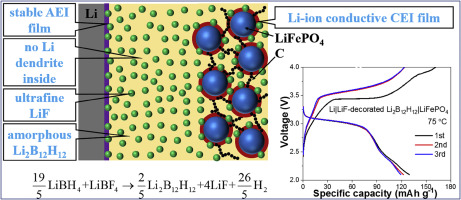Materials Today Nano ( IF 10.3 ) Pub Date : 2020-04-01 , DOI: 10.1016/j.mtnano.2020.100079 X. Shi , Y. Pang , B. Wang , H. Sun , X. Wang , Y. Li , J. Yang , H.-W. Li , S. Zheng

|
The unstable solid electrolyte/electrode interface with dendrite growth and resistance increase significantly reduces the safety and efficiency of all-solid-state batteries. Here, we propose an ‘in situ LiF nanodecoration’ approach to address this issue. By uniform dispersion of ultrafine LiF nanoparticles in amorphous Li2B12H12 matrix that is in situ formed via a solid-state reaction, the resulting composite as electrolyte exhibits favorable Li-ion conductivity (5 × 10−4 S cm−1) with low electronic conductivity (9 × 10−10 S cm−1) at 75 °C. More importantly, this composite electrolyte shows superior electrode compatibility by forming stable electrolyte/electrode interfaces, as demonstrated by high Li dendrite suppression capability (critical current density: 3.6 mA cm−2) and small interfacial resistance (area specific resistance after 10 cycles: 746 Ω cm2) at 75 °C, which further enables the stable cycling of Li–LiFePO4 all-solid-state batteries. This work paves a way for using in- situ nanodecoration chemistry for the design of safe and high efficiency all-solid-state batteries.
中文翻译:

原位形成LiF纳米装饰电解质/电极界面,用于稳定的全固态电池
具有枝晶生长和电阻增加的不稳定的固体电解质/电极界面显着降低了全固态电池的安全性和效率。在这里,我们提出了一种“原位LiF纳米装饰”方法来解决此问题。通过将超细LiF纳米颗粒均匀分散在通过固态反应原位形成的非晶态Li 2 B 12 H 12基质中,所得复合材料作为电解质表现出良好的锂离子传导性(5×10 -4 S cm -1)电子传导率低(9×10 -10 S cm -1)在75°C下。更重要的是,这种复合电解质通过形成稳定的电解质/电极界面而表现出优异的电极相容性,如高锂枝晶抑制能力(临界电流密度:3.6 mA cm -2)和小界面电阻(10次循环后的面积比电阻:746)所证明Ωcm 2)在75°C,这进一步使Li–LiFePO 4全固态电池稳定循环。这项工作为使用原位纳米装饰化学技术设计安全高效的全固态电池铺平了道路。



























 京公网安备 11010802027423号
京公网安备 11010802027423号